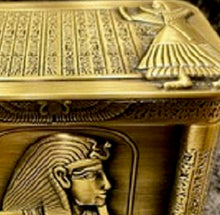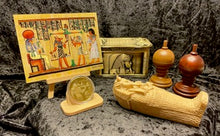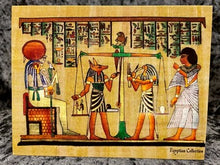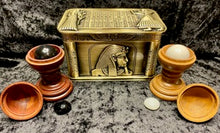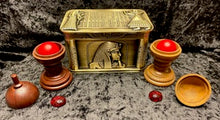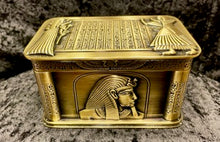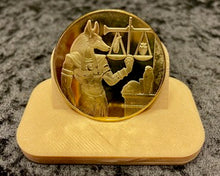
ONLY TWO AVAILABLE (NO COA)
The Stone of Tutankhamun
In November of 1922, Howard Carter discovered the tomb of King Tutankhamun of
Egypt. Among the over 8000 items found inside the tomb were two stones, one black
and one white, that had served as jewels on Tutankhamun’s sarcophagus. Taken by
Carter, the stones began to demonstrate apparent magical powers. Those powers can
still be demonstrated today, with the use of these two magnificent wooden vases, also
found among the items in Tutankhamun’s tomb.
The performer now begins to demonstrate the power of the Stones of Tutankhamun.
The stones are laid out, one in front of each vase, and are said to designate the color of
the ball contained in each vase. The lids are removed and the balls are dumped out
and shown to match the colors of the stones. The balls are put in the performer’s
pockets and the lids are returned to the vases, but immediately the balls return to their
respective vases. Once again, the balls are dumped onto the table as they are
revealed, then replaced in their respective vases, and the lids are replaced. The
stones’ locations are switched, and when the lids are removed this time, the balls have
apparently followed their stones…they have transposed to match the stones in front of
the vases! The balls, having been dumped onto the table once again, are placed into
the performer’s pockets and the lids returned to the empty vases. This time, the
stones are returned to their original locations, and when the lids are removed, the balls
have returned, again following their respective stones! One last time, the balls are
returned to the pockets and the empty vases capped. The black and white stones are
placed between the hands and rubbed back and forth so as to heat them up. After
vigorously rubbing the stones between the hands, they are dropped to the table, where
they are seen to have turned red in color! The lids are immediately removed from the
vases to show the balls have returned again, but this time they, too, are both red!
While the effect is accomplished without the aid of any gaffs, the sleight of hand
required to accomplish this baffling effect is easily within reach of anyone willing to
devote time to a little practice. And for the collector, there are several additional pieces
to this ensemble the render a beautiful display.
Here is what you get:
One metal, velvet-lined Egyptian-themed box
Two beautiful hand-turned mahogany ball vases (no shells), one dark and one light
Six colored wooden balls (2 red, 2 white, and 2 black)
Four colored stones (1 white, 1 black, and two red)
One King Tut sarcophagus containing a thumb drive with performance and instruction
video
One Egyptian coin with display stand
One Egyptian-themed Certificate of Authenticity with display easel
One written instruction booklet







